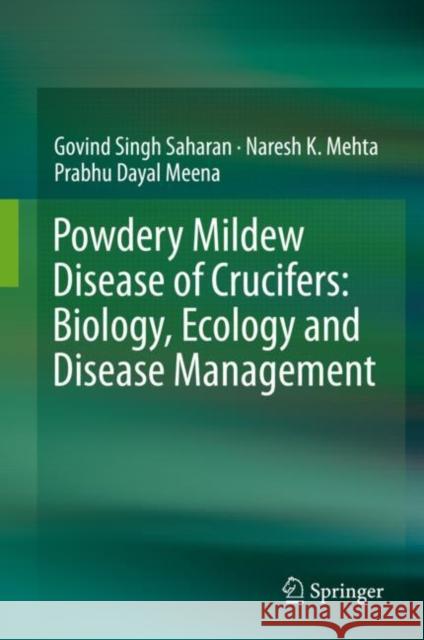Powdery Mildew Disease of Crucifers: Biology, Ecology and Disease Management » książka



Powdery Mildew Disease of Crucifers: Biology, Ecology and Disease Management
ISBN-13: 9789811398520 / Angielski / Twarda / 2019 / 362 str.
Powdery Mildew Disease of Crucifers: Biology, Ecology and Disease Management
ISBN-13: 9789811398520 / Angielski / Twarda / 2019 / 362 str.
(netto: 576,41 VAT: 5%)
Najniższa cena z 30 dni: 578,30
ok. 22 dni roboczych.
Darmowa dostawa!
1) Powdery Mildew Perspective .- 2)The Disease- Powdery mildew.- 3) The Pathogen.- 4) Infection, Pathogenesis, and Disease cycle.- 5) Fine Structures, and Electron Microscopy.- 6) Epidemiology, and Forecasting.- 7) Host Resistance.- 8) Disease Management.- 9) Techniques.- 10) Powdery mildew epilogue.- 11) Future research priorities of crucifer’s powdery mildew.- 12) Subject Index.
Dr. Govind Singh Saharan
Dr. Govind Singh Saharan, is ex. professor and head, Department of Plant Pathology. He served as Lecturer, and Assistant Professor at HPKVV, Palampur, and as Associate Professor, Professor and Professor and Head at Department of Plant Pathology, CCS Haryana Agricultural University, Hisar. Dr. Saharan has been a visiting Professor at the Department of Plant Sciences, University of Alberta, Edmonton, Canada, Agriculture and Agri-Food Canada, Saskatoon Research Sattion, Saskatoon, Canada, and Rothamsted Research, IACR, Harpenden, UK.
Dr. Saharan has more than 260 research publications in Journals of National and International repute. He has been editor of books, Annual Reviews and has authored monographs and books on diseases of oilseed crops. He has guided M. Sc. and Ph. D. students who are well established scientists at different universities, and research organizations in India and abroad.
Dr. Saharan has conducted research in diverse fields of Plant Pathology including standardization of artificial inoculation techniques, identification of sources of resistance, determination of pathogenic variability, genetics of host-parasite interaction, epidemiology, and management of several diseases. He has been President (North Zone) of the Indian Phytopathological Society, Editor-in-Chief of Journal of Mycology and Plant Pathology, and Journal of Oilseed Brassica, and President of the Indian Society of Mycology and Plant Pathology. Dr. Saharan has been bestowed with Y.L. Nene outstanding Plant Pathology Teacher Award, and Life Time Achievement Award for his outstanding research leadership, and expertise in oilseed Brassica research.
Dr. Naresh Kumar Mehta
Dr Mehta served as Assistant Scientist (Plant Pathology), Scientist/Assoc. Professor and Professor and Associate Dean at CCS HAU, Hisar. He has been teaching Plant Pathology courses to undergraduate and postgraduate students. He has conducted research in diverse fields of Plant Pathology covering pathogenic variability, genetics of host pathogen interaction, epidemiological studies, identification of resistant sources, biochemical/genetical basis for resistance, residual analysis of fungicides, and disease management. Dr Mehta was member of Expert Committee, UGC, New Delhi and as expert on the panel of various universities. Dr. Mehta is editor and author of books on diseases of oilseed crops. He has published more than 100 research papers in the journals of National and International repute. In additions, review articles, book chapters, practical manuals, lead lectures in the conferences, research paper presentations and popular articles are to his credit.
Dr. Mehta has been admitted as Fellows of Indian Phytopathological Society, New Delhi, (FPSI), Indian Society of Plant Pathologist, Ludhiana, (FINSOPP), and Indian Society of Mycology and Plant Pathology, Udaipur, (FISMPP). He has been on the editorial board of Indian Phytopathological Society, Councilor (North Zone) of ISMPP, member of editorial board, and Editor-in-Chief of ISMPP. Dr. Mehta has been a visiting scientist to University of Alberta, Edmonton, Canada.
Dr. Prabhu Dayal Meena
Dr. Prabhu Dayal Meena, is working as Principal Scientist (Plant Pathology) at the Directorate of Rapeseed-Mustard Research (Indian Council of Agricultural Research), Bharatpur, Rajasthan, India. He served as a Senior Technical Assistant at Central Soil & Water Conservation Research & Training Institute, Dehradun. He has published more than 60 research papers, reviews, and book chapters in International and National reputed refereed journals, and editor of books and author of books on diseases of oilseed crops.
He has been honored with Fellowship of Indian Society of Mycology and Plant Pathology, Fellow of Plant Protection Association of India, and also awarded with Dr. P.R. Kumar Outstanding Brassica Scientist Award. He has served as Councilor of Plant Protection Association of India, the founder Secretary of the Society for Rapeseed-Mustard Research, and a member of the editorial board, and managing editor for the Journal of Oilseed Brassica.
Dr. Meena has been a Principal Investigator (PI) and Co-PI of ICAR. He is the recipient of best paper presentation award. He undertook research attachment training at the Rothamsted Research, Harpenden, UK under Indo-UK Collaborative Research on Oilseed Brassica crops. He has supervised M. Sc. and Ph D. students.
Powdery mildew disease is the fourth most widespread disease in cruciferous crops and a devastating effect, causing significant losses in terms of quality and quantity in rapeseed and mustard. Powdery mildews are also a favourable host-pathosystem model for basic research on host–parasite interactions, developmental morphology, cytology, and molecular biology to identify the effector proteins/genes governing different biological functions.
This book provides a comprehensive overview of all the published information in the field for researchers, teachers, students, extension experts, industrialists and farmers, and includes illustrations, photographs, graphs, figures, tables, histograms, micrographs, electron micrographs, and flow charts to aid understanding. It also describes standardized reducible techniques. The book discusses each disease in detail, describing the distribution, symptomatology, host range, yield losses and disease assessment, as well as the taxonomy, morphology, phylogeny, variability, sporulation, survival and perpetuation of the pathogen. Further, it explores topics such as spore germination; infection; pathogenesis; disease cycle; epidemiology; forecasting; fine structures; host resistance; biochemical, histological, genetic and molecular aspects such as cloning and mapping of R genes; sources of resistance; disease resistance breeding; and the genetics of host-parasite interactions and disease management.1997-2026 DolnySlask.com Agencja Internetowa
KrainaKsiazek.PL - Księgarnia Internetowa









